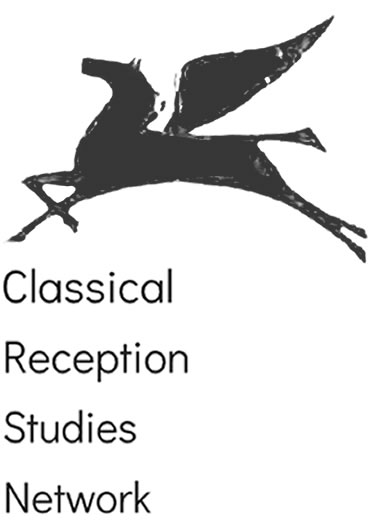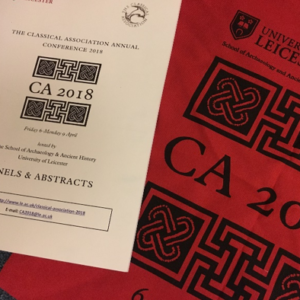by Ben Greet
Classical reception studies were well represented at this year’s Classical Association Conference, which was superbly organised and hosted by The University of Leicester’s School of Archaeology and Ancient History. I spent my four days there exploring a huge diversity of receptions, from Sapphic fan-art to gender in Ulysses.
The first panel I attended was, predictably, the one I was involved in: ‘Position and Power in Comics’, where I started the discussion by looking at representations of Hippolyta within modern Wonder Woman comics. This was followed by Harriet Lander, who explored fan-art of Sappho based around two famous Victorian paintings. Dr Lynn Fotheringhamwas next, discussing the representations of violence in Three, a historical comic series dealing with the Spartan Crypteia. Finally, Dr Carl Buckland, who organised the panel, wrapped up with an examination of how depictions of the monstrous reflected contemporary politics in Greg Rucka’s Wonder Woman comics.

The second panel I attended, simply entitled ‘Classical Reception’, approached reception through a trio of different media. It began with Dr Ben Earley discussing the ‘Thucydidean Turn’ in scholarship after WWI. While using some really engaging anecdotes, he discussed Thucydides’ role as a contemporary author, a tragic figure, and social psychologist. Next up was Prof. Mark Padilla’s fascinating insights into the parallels between The Odyssey and Alfred Hitchcock’s The 39 Steps. This paper was following on from his recent book: Classical Myth in Four Films of Alfred Hitchcock. Lastly, Dr Barnaby Chesterton introduced the attendees to two classically-influenced video games: The Talos Principle and Apotheon. Both games make heavy use of ancient visual culture in order to enhance both their plot and style.

After lunch, I attended the panel organised around the 50thanniversary of 2001: A Space Odyssey. This panel, entitled ‘Wandering from Clime to Clime: Science Fictional Odysseys’, explored the use of The Odyssey in science fiction film, television, and comics. To kick things off, Dr Tony Keen looked at whether 2001 was even connected to the classical Odyssey at all, attempting to fit it into a particular category of reception. He was followed by Sarah Gouldesbrough, who explored representations of The Odyssey in three comics: The Infinite Horizon, Le Dernier Troyen, and ODY-C. These comics explored themes of PTSD, LGBT relationships, and gender politics respectively, using the familiar characters and situations from The Odyssey. Dr Juliette Harrison then focused on conceptions of nostos, particularly a return to safety, in The Odyssey and showed how these were reflected within the finales of Star Trek: Voyager and Battlestar Galactica. To round out the panel, Dr Nick Lowe then discussed the intersection between The Odyssey and the entire genre of science fiction. His paper succinctly traced ten distinctive narrative tropes within modern science fiction back to Homer’s epic.

I started my Sunday morning exploring a different facet of classical reception studies: the afterlives of ancient artefacts. The panel ‘Speaking Objects’ explored how ancient sculpture and pottery have been received since its discovery and how they have been displayed. The morning started with Dr Sadie Pickup’s paper on the differing reception of the Knidian and Melian Aphrodites. Sally Waites followed by tracking four pots in the Thomas Hope collection, demonstrating their impact on interior designs of the 19thcentury. Anna Reeve, who organised the panel, then explored the ‘itineraries’ of two Cypriot pots within the Kent collection in Harrogate and how they were witness to pivotal moments in ancient Cypriot scholarship. Lastly, Dr Emma Stafford recounted her experiences of organising the display of Marian Maguire’s The Labours of Herakles at museums across Europe, comparing approaches and audience responses.

Although the last panel I attended on Monday was not intentionally themed, all the papers were still connected through the representation of woman in both classical and modern material. Dr Vassiliki Kotini explored the representation of Clytemnestra in Steven Berkoff’s Agamemnon, while Karen Possingham compared Penelope in The Odyssey to James Joyce’s Molly Bloom in Ulysses. Finally, Anne Ploin’s paper took an intriguing approach to exploring the character of Eurydice in Anne Carson’s translation of Electra by linking her work and ideas with a contemporary artist: Aliki Krikidi.
And these are just the papers I attended. There were plenty of fascinating reception papers and panels I missed. A whole panel was dedicated to Renaissance receptions and another to the reception of Thebes in antiquity and beyond. There were even some instances of classical reception scattered around the conference halls, my personal favourite being the ‘Artefact to Art’exhibition. This was a competition run alongside the conference where artists of all ages submitted new works of art and poetry based on ancient artefacts, each of which stood as a unique piece of classical reception.

